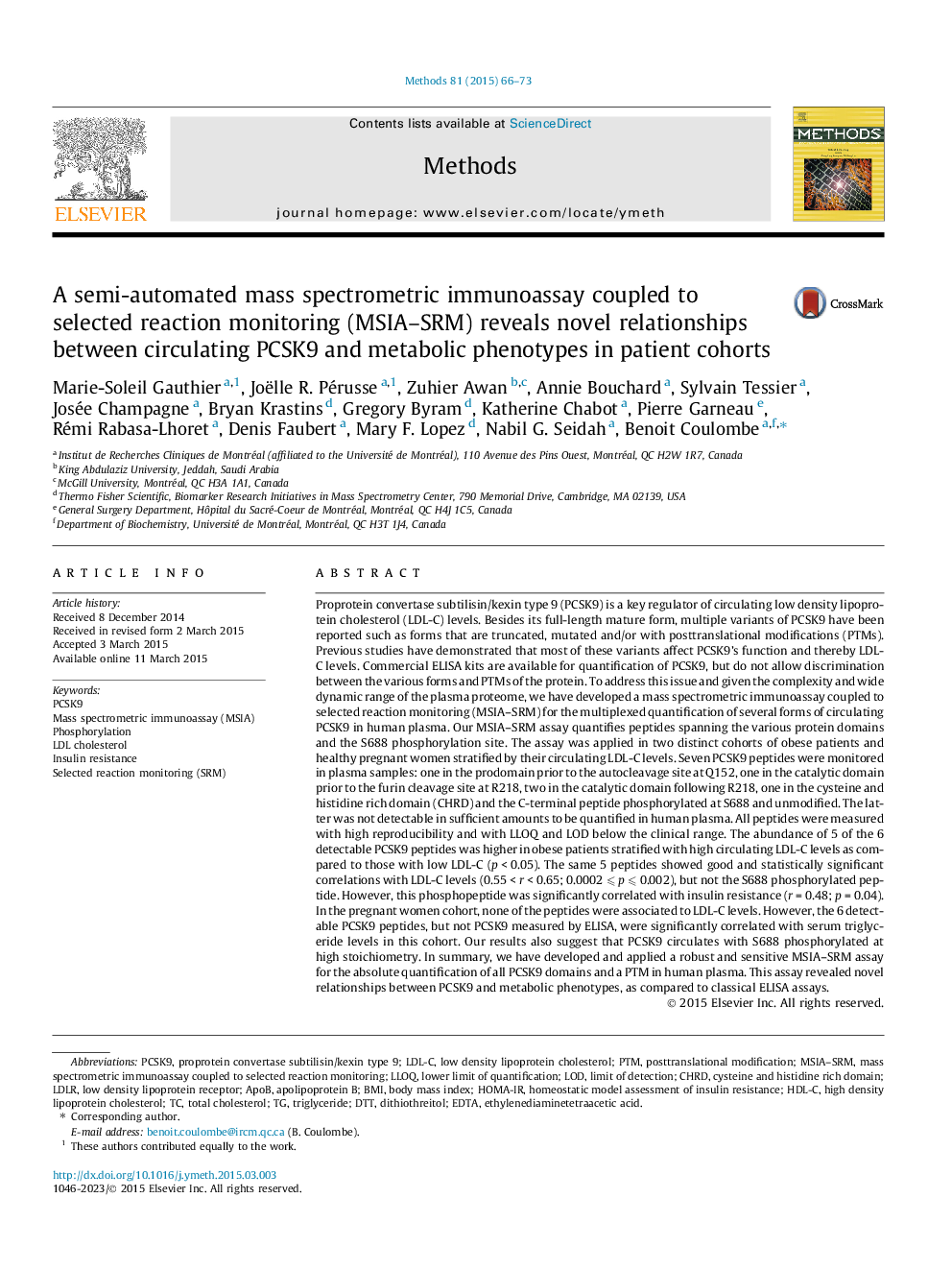| کد مقاله | کد نشریه | سال انتشار | مقاله انگلیسی | نسخه تمام متن |
|---|---|---|---|---|
| 1993285 | 1541245 | 2015 | 8 صفحه PDF | دانلود رایگان |

• Multiplexed quantitative, mass spectrometric immunoassay for variants of PCSK9.
• Application of PCSK9 MSIA–SRM assay in cohorts of patients.
• The majority of plasma PCSK9 molecules are phosphorylated at S688.
• PCSK9 MSIA–SRM assay reveals novel relationships between PCSK9 and metabolic phenotypes.
Proprotein convertase subtilisin/kexin type 9 (PCSK9) is a key regulator of circulating low density lipoprotein cholesterol (LDL-C) levels. Besides its full-length mature form, multiple variants of PCSK9 have been reported such as forms that are truncated, mutated and/or with posttranslational modifications (PTMs). Previous studies have demonstrated that most of these variants affect PCSK9’s function and thereby LDL-C levels. Commercial ELISA kits are available for quantification of PCSK9, but do not allow discrimination between the various forms and PTMs of the protein. To address this issue and given the complexity and wide dynamic range of the plasma proteome, we have developed a mass spectrometric immunoassay coupled to selected reaction monitoring (MSIA–SRM) for the multiplexed quantification of several forms of circulating PCSK9 in human plasma. Our MSIA–SRM assay quantifies peptides spanning the various protein domains and the S688 phosphorylation site. The assay was applied in two distinct cohorts of obese patients and healthy pregnant women stratified by their circulating LDL-C levels. Seven PCSK9 peptides were monitored in plasma samples: one in the prodomain prior to the autocleavage site at Q152, one in the catalytic domain prior to the furin cleavage site at R218, two in the catalytic domain following R218, one in the cysteine and histidine rich domain (CHRD) and the C-terminal peptide phosphorylated at S688 and unmodified. The latter was not detectable in sufficient amounts to be quantified in human plasma. All peptides were measured with high reproducibility and with LLOQ and LOD below the clinical range. The abundance of 5 of the 6 detectable PCSK9 peptides was higher in obese patients stratified with high circulating LDL-C levels as compared to those with low LDL-C (p < 0.05). The same 5 peptides showed good and statistically significant correlations with LDL-C levels (0.55 < r < 0.65; 0.0002 ⩽ p ⩽ 0.002), but not the S688 phosphorylated peptide. However, this phosphopeptide was significantly correlated with insulin resistance (r = 0.48; p = 0.04). In the pregnant women cohort, none of the peptides were associated to LDL-C levels. However, the 6 detectable PCSK9 peptides, but not PCSK9 measured by ELISA, were significantly correlated with serum triglyceride levels in this cohort. Our results also suggest that PCSK9 circulates with S688 phosphorylated at high stoichiometry. In summary, we have developed and applied a robust and sensitive MSIA–SRM assay for the absolute quantification of all PCSK9 domains and a PTM in human plasma. This assay revealed novel relationships between PCSK9 and metabolic phenotypes, as compared to classical ELISA assays.
Journal: Methods - Volume 81, 15 June 2015, Pages 66–73